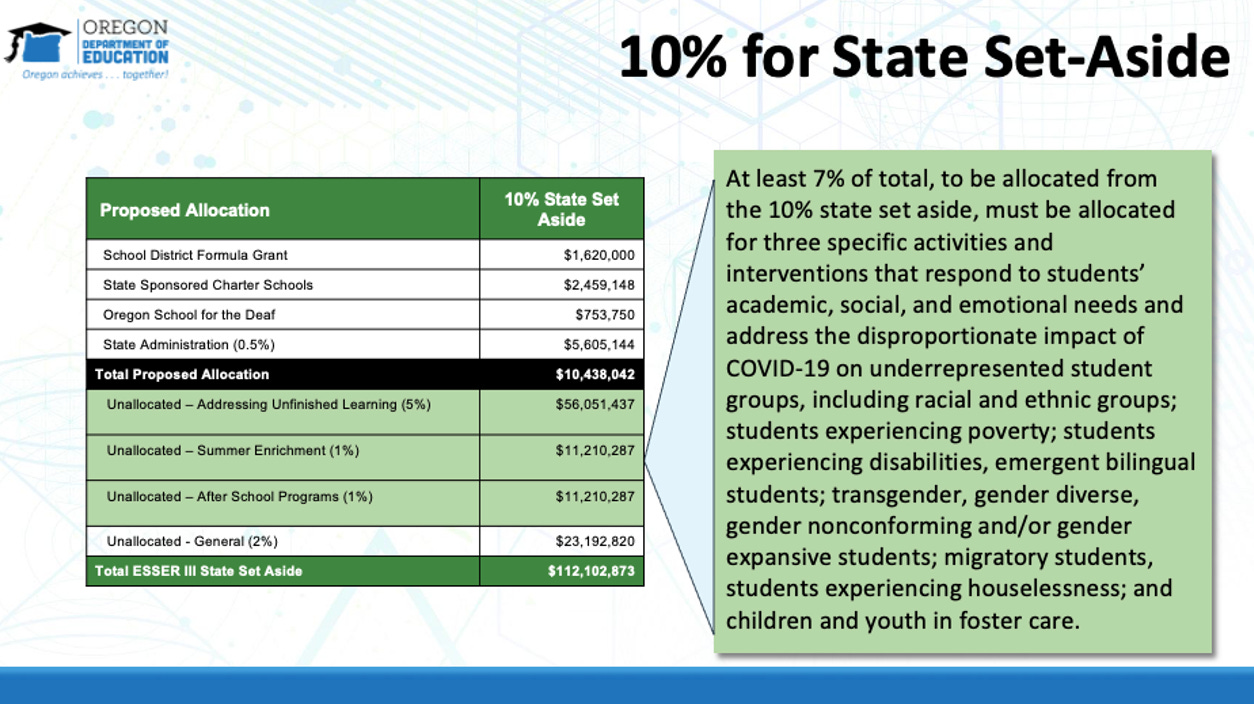Students, Parents, and all Oregonians Deserve Transparency from their Department of Education
The federal funds allocated to school districts have the potential to transform our educational environment but only if the public can monitor the use of those funds.
The last two years have been brutal for anyone involved in education. School districts—their teachers, staff and boards—are exhausted. And now they are faced with yet another challenge: how to spend COVID-relief funds.
Congress passed the American Rescue Plan Elementary and Secondary School Emergency Relief (ESSER) bills to help schools address pandemic-related issues. Oregon’s ESSER allocations total $1.7 billion for the years 2020-2024. (Funding by Oregon district).
The funds are of course welcome but spending such large sums is difficult because of the short timeline and their one-time nature. The ODE cautioned districts to “avoid using stimulus funds to pad budget shortfalls, reinvest in the status quo or layering in ‘add on’ approaches that will disappear when the funds run out.” Responsible spending of these funds requires transparency, a look at where we aren’t meeting students’ needs, and careful thought about sustainable funding for the future.
Transparency
Effective planning and accountability to the public require transparency. Georgia and Arkansas have created online dashboards so the public can see how districts and their state ODEs are spending funds. Oregon has no such dashboard.
As of the writing of this article, ODE was unable to provide any detailed use of funds spent by districts or by the ODE. Responding to questions, Cynthia Stinson, ODE Senior Manager of Federal Investments & Pandemic Renewal, wrote: “To date, the Oregon Department of Education has allocated a small portion of our set aside dollars. The federal law requires the set aside to be fully obligated by March 24, 2022. ODE’s final plan for allocation of the rest of the set aside will be posted on the ODE website on December 8. An outline of what has been allocated thus far is as follows”:
The above breakdown is almost identical to the June ODE presentation shown below. An approved capital expenditures list on the ODE website shows that districts have spent ESSER funds on items such as turf, floor scrubbers, and bleachers, but does not include precise funding amounts.
This mirrors problems in other states. ProPublica recently reported on numerous examples of inappropriate uses of ESSER funds, such as spending on stadiums or nature centers, and not on the pandemic’s negative impact on vulnerable students. In one Iowa district, an investigation has already been opened because of how poorly students with disabilities were served during the pandemic.
Oregon needs an ESSER dashboard and a state-wide plan to address unfinished learning. Currently we have neither, but other states can provide guidance if we act quickly. I suggest one model below.
Addressing Unfinished Learning
The pandemic has had the greatest negative impacts on students who were already struggling. The ODE acknowledges this in their ESSER plan and said they will give top priority to supporting those students and addressing the academic impact of lost instructional time. We also know that the pandemic widened existing inequalities. A recent report noted, “achievement was lower for all student groups in 2020-21; however, American Indian and Alaska Native (AIAN), Black, and Latinx students, as well as students in high-poverty schools were disproportionately impacted, particularly in the elementary grades we studied.”
In a previous post, I explained the severity of Oregon’s literacy crisis. In 2019, only 47% of Oregon third graders were proficient in reading. We know the current numbers are even worse.
Many states and districts are using ESSER funds to train their teachers in the science of reading to ensure that all children are taught to read. They are doing so because they know that reading is the foundation of all other learning. Increased literacy leads to more positive outcomes in academic, social-emotional, and economic realms. (Examples of states plans to use funding for teacher training: OK, UT, MN, MI, KS, OH).
In a June ODE presentation, the allocation of the state set-aside ESSER funds listed $56 million under “unfinished learning” and another $23 million under “general fund.” Advocates, including teachers, superintendents, and principals, have asked the ODE to use $20 million of this state set-aside to train teachers in our most struggling schools. Using ESSER funds to train teachers is a one-time expense that will pay off now and for years to come, without burdening future budgets.
As of now, this funding request has not been granted, nor has any information been made public about plans for the $112 million in the state set-aside.
When asked how ODE was engaging the public around use of the set aside funds, ODE’s Cynthia Stinson wrote:
Oregon Department of Education hosted three ESSER III Refinement Roundtables on November 17, 2021 as a follow up to our ESSER III Community Engagement sessions hosted in May 2021. The purpose of these roundtables in November were to share the ESSER III Set Aside Investment Plan for final refinement and input. We will be compiling a report to synthesize the themes from the Refinement Roundtables and using that information to formally finalize and make public the Oregon ESSER III Set Aside Investment plan.
Beginning in August, advocates for using ESSER funds for teacher training asked repeatedly how they could show community support for their funding request. They were not invited to, nor told about, these “Refinement Roundtables.” No information about the events or who attended is publicly available.
An Opportunity for State Leadership on Education
Oregon is a “local control state,” meaning that 197 locally elected boards govern and manage public schools. Local control requires accountability but without more guidance and transparency from the governor’s office and the ODE, the public will not know how billions are being used by districts or the state. The public’s trust in the ODE, the governor’s office, and elected officials is at stake.
We have an opportunity to turn the page on our literacy crisis. ESSER funding can be used to reimburse expenses up until September 2024. That gives us almost three years to train our teachers, starting with those at the most struggling schools.
The ODE’s presentation to districts explained that with ESSER funding, “school districts have unprecedented power to respond to meet students’ needs and ensure that we don’t ‘return to the old normal’ when new funding expires.” But ODE’s failure to implement basic accountability measures like funding dashboards undermines the public’s ability to hold their local school boards to account. ODE must train all of its teachers to teach all kids to read. None of us want to return to the old, inequitable normal.
Jennifer is a literacy advocate with Oregon Kids Read and has worked in finance, academics, and nonprofits. She also writes novels and draws one-panel cartoons.
Photo credit: "2018 Walk + Roll to School Day at Whitman Elementary" by Portland Bureau of Transportation is licensed under CC BY-NC-ND 2.0








Reading teachers, not training teachers should come first. Ome addresses immediate needs and the other addresses long range needs. The funds are for immediate needs.